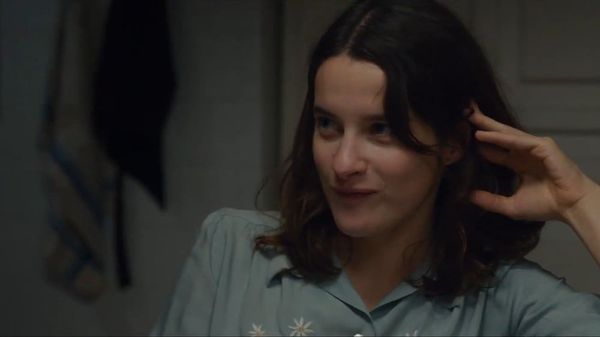Eye For Film >> Movies >> A Radiant Girl (2021) Film Review
A Radiant Girl
Reviewed by: Anne-Katrin Titze

Sandrine Kiberlain’s début feature, A Radiant Girl (Une Jeune Fille Qui Va Bien), which had its world premiere at the Critics’ Week of the 2021 Cannes Film Festival, contains sparkling moments of illumination where the historical context of Paris in the summer of 1942 enters into a dialogue with lines by Marivaux from 1740, as well as a coming-of-age tale that is as old and new as theatre itself. Irène, played by the magnificent Rebecca Marder (a member of the Comédie Française who also stars in Arnaud Desplechin's Deception), is well on her way to become an actress. She is a force of nature who can’t sit still, and the “radiant” of the English title (in the original French she is merely doing well) is no exaggeration. Her energy level and enthusiasm for make-belief can be a nuisance for her father (André Marcon) and her older brother Igor (Anthony Bajon). Her grandmother Marceline (Françoise Widhoff) is the one she confides in about crushes and not-so crushes on boys.
In the evening, she works as an usher in the theatre and during the day, she rehearses with her gang of acting friends and prepares for the entrance exam of the conservatory. When Jo (Ben Attal) disappears with no warning, Irène is left without a partner for her audition piece from L'Épreuve by Pierre de Marivaux. Her friend Viviane (India Hair) comes to the rescue, adding some additional interesting gender dynamics. The theatre atmosphere and close inspection of first love turmoil at times made me think of last year’s debut feature of Kiberlain’s daughter, Suzanne Lindon’s Spring Blossom. (Is Suzanne’s father, Vincent Lindon, who stars in this year’s Palme d’Or winner, Julia Ducournau’s Titane, the next to direct a feature?)

Kiberlain plays down the period. No swastikas flap in the wind to signal the Occupation. The costumes by Emmanuelle Youchnovski have a timeless quality. Irène’s dresses, her favourite jacket, and her brandy-coloured cross-body bag would not look out of place today. The streets and interiors are uncluttered and rather minimal, which is a wise choice.
One of A Radiant Girl’s first sequences includes a fainting spell, which introduces a motif that is woven throughout the narrative (Kiberlain also wrote the screenplay). Irène is precocious, and her family and friends, as well as strangers, including us, can never be certain if what she does is a real affliction or great acting. This kind of play with emotions adds a hint of cruelty to her, one that is easily excusable as youthful carelessness in peace time. During the Occupation, though, and as a member of a Jewish family, staying out late heightens the selfishness to an almost unbearable degree (the issue is addressed in the film, but Kiberlain seems to have lost track a little about the order of when scenes occur.)
The restrictions imposed on the Jewish population in 1942 trickle into the film one by one. A decision has to be made. The word “Jew” must be stamped in red on passports. Grandma is against it and sews the family’s ID cards into the lining of a fabric handbag. The father, a public accountant, on the other hand, is all set to obey the officials. Irène, who is getting glasses, not because she needs them, but because she has a crush on Jacques (Cyril Metzger), assistant to the family doctor, is asked if the dizzy spells might be related to her anxiety about the current state of events. “No,” she says, “I’m not anxious.” We wholeheartedly believe her because how can the personification of life think of death?
The best scenes are those where the human condition and awareness of teenagers everywhere at the cusp of adulthood encounters the unfathomable. When they hear of an acquaintance being arrested, the father differentiates that she was “a Polish Jew,” and “we’re French, it’s different.” He has the ID cards stamped and tells the kids that “everything is in order now.” Igor counters “as if we had no choice.” The scene is so bone-chilling because we are forced to stare into the abyss between the audience’s knowledge and the characters’ predicament in the moment.
A meeting between Igor’s girlfriend Héloïse (Léa Rostain) and Irène on the street, where the former puts a touch of lipstick on the cheeks of the latter, is one of the film’s most powerful scenes. Nothing much happens, all is in the glances and the knowledge you may have about a time and place when rosy cheeks could decide between life and death. Igor, who just got handed back his newly stamped ID which he showed to his friends, looks on. With his whisper of a moustache he resembles a pale, young version of Rainer Werner Fassbinder. It is a Fassbinder moment that for a second also linked for me the girls to the post-war heroines across borders and time.
With radios, telephones, and bicycles turned in on demand by the occupiers, as Irène’s father states, “everything that connects us to the outside world”, the restrictions are mounting. When the wearing of the yellow star becomes obligatory, the film for the first time allows us a more exact time stamp. We are in June 1942, the Vél d'Hiv Roundup a mere month away.
Kiberlain’s music choices are idiosyncratic. Some work better than others. After the first kiss with Jacques, the choice of so clearly anachronistic a song catapults you out of the picture completely. This is not Bow Wow Wow’s I Want Candy in Sofia Coppola’s Marie Antoinette. Tom Waits, on the other hand, has a timeless quality anyway and when he sings of “the old days” which lie in the characters’ future in All The World Is Green, the warping is inspired. The most rewarding impact comes when Igor as part of a youth orchestra begins to play “Que reste-t-il de nos amours,” the famous Charles Trenet song, released in 1942. The melancholy reserved for a more mature age has set in early. When lies and injustice rule, there isn’t a second to waste.
Reviewed on: 18 Jul 2021














